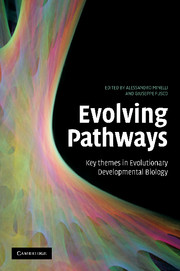Book contents
- Frontmatter
- Contents
- Contributors
- Preface
- Introduction: Pathways of change
- Part I Thinking about evolution by taking development on board
- Part II Evo-devo: methods and materials
- 7 A pragmatic approach for selecting evo-devo model species in amniotes
- 8 On comparisons and causes in evolutionary developmental biology
- 9 Evolution and development: towards a synthesis of macro- and micro-evolution with ecology
- 10 When is a Hox gene not a Hox gene? The importance of gene nomenclature
- 11 Plants are used to having identity crises
- Part III Evolving diversity
- Part IV Evolving body features
- Index
- References
7 - A pragmatic approach for selecting evo-devo model species in amniotes
Published online by Cambridge University Press: 08 August 2009
- Frontmatter
- Contents
- Contributors
- Preface
- Introduction: Pathways of change
- Part I Thinking about evolution by taking development on board
- Part II Evo-devo: methods and materials
- 7 A pragmatic approach for selecting evo-devo model species in amniotes
- 8 On comparisons and causes in evolutionary developmental biology
- 9 Evolution and development: towards a synthesis of macro- and micro-evolution with ecology
- 10 When is a Hox gene not a Hox gene? The importance of gene nomenclature
- 11 Plants are used to having identity crises
- Part III Evolving diversity
- Part IV Evolving body features
- Index
- References
Summary
One major classical justification of using a model metazoan species for experimentation has been that discoveries of biological phenomena in that species could be extrapolated to other multicellular species. Because the chances that this extrapolation is valid in humans depend on the phylogenetic distance between humans and the model species, many researchers have somewhat sacrificed the major benefits of small size, short generation time and ease of manipulation that characterise some invertebrates in order to use species that humans can more readily relate to, such as the laboratory mouse (Mus musculus). However, the community of biologists has continued to use additional model species because each of the selected taxa have specific features that make experimental manipulation easier (e.g. easy-to-score morphological variation and giant polytene chromosomes in Drosophila melanogaster, or accurate description of the largely invariant complete cell lineage and full neural connectivity in the roundworm Caenorhabditis elegans).
Ever since the molecular genetic revolution, a constant concern has been the possibility of manipulating the genome of model species. For example, generations of Drosophila scientists have developed and applied ingenious approaches that allow, in principle, screening for any phenotype at any stage of development (reviewed in St Johnston 2002). Even for the mouse model, multiple techniques, such as homologous recombination, tissue-specific activation/inactivation techniques, cloning and RNA interference (RNAi), have been developed for performing genotype- or phenotype-driven experiments. Furthermore, recent access to full genome sequences makes genome engineering of some model species easier.
- Type
- Chapter
- Information
- Evolving PathwaysKey Themes in Evolutionary Developmental Biology, pp. 123 - 143Publisher: Cambridge University PressPrint publication year: 2008
References
- 13
- Cited by



